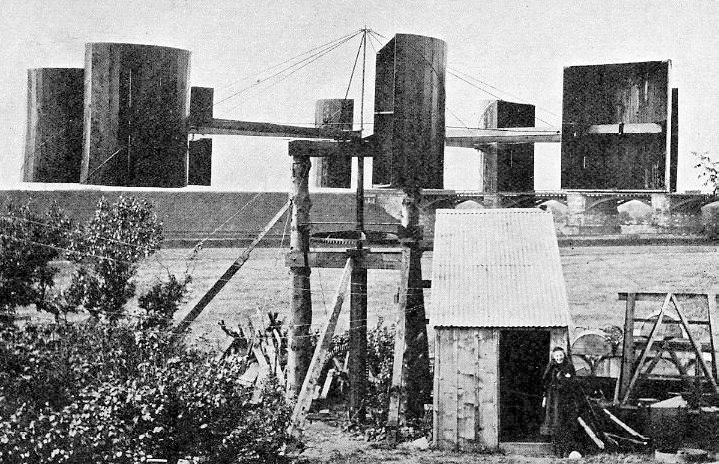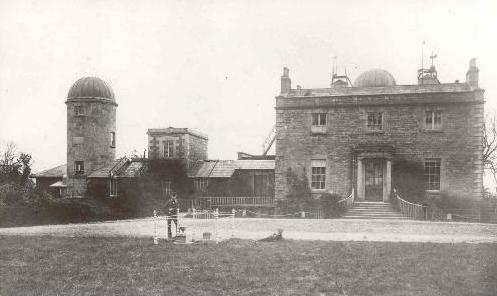|
James Blyth (engineer)
Professor James Blyth MA, LLD, FRSE FRSSA (4 April 1839 – 15 May 1906) was a Scottish electrical engineer and academic at Anderson's College, now the University of Strathclyde, in Glasgow. He was a pioneer in the field of electricity generation through wind power and his wind turbine, which was used to light his holiday home in Marykirk, was the world's first-known structure by which electricity was generated from wind power. Blyth patented his design and later developed an improved model which served as an emergency power source at Montrose Lunatic Asylum, Infirmary & Dispensary for the next 30 years. Although Blyth received recognition for his contributions to science, electricity generation by wind power was considered uneconomical and no more wind turbines were built in the United Kingdom until 1951, some 64 years after Blyth built his first prototype. Early life James Blyth was born in Marykirk, Kincardineshire, on 4 April 1839 to John Blyth, an innkeeper and sma ... [...More Info...] [...Related Items...] OR: [Wikipedia] [Google] [Baidu] |
Marykirk
Marykirk ( gd, Obar Luathnait) is a village in the Kincardine and Mearns area of Aberdeenshire, Scotland, next to the border with Angus at the River North Esk. The village is approximately 6 miles ENE of Montrose at the southern end of the Howe of the Mearns. The road bridge carrying the A937 over the River North Esk is a substantial structure with four arches. It was designed by Robert Stevenson and completed in 1815 at the cost of £1,000 replacing the previous route to the village, an ancient ford. There is a rail bridge across the same river some 600 m north of the road bridge and the village once had a rail station to the north east. The present parish church was rebuilt in 1806 replacing the previous church, the remains of which can be found in the adjacent kirkyard. The older church was dedicated to St Mary and consecrated in 1242 by the Bishop de Bernham. The settlement and parish were called Aberluthnot before being renamed after the church. The village was made a b ... [...More Info...] [...Related Items...] OR: [Wikipedia] [Google] [Baidu] |
Morrison's Academy
Morrison's Academy is a co-educational independent day school in Crieff, Perth and Kinross, in Central Scotland. The school provides nursery, primary and secondary school facilities. It draws many pupils from surrounding Perth and Kinross and Stirling. History Morrison's Academy owes its foundation to Thomas Morison (also spelled Morrison). Born in 1761 in the village of Muthill; his mother belonged to Crieff. Morison trained as a stonemason and, after working some years in Auchterarder, he moved to Edinburgh and set up his own business. He made his fortune as the builder of a substantial part of the city's beautiful Georgian New Town (the sections north of Queen Street). Morison died age 59 on 30 August 1820 in Edinburgh. He had no children and, rather than letting his entire fortune fall into the hands of relatives, directed his trustees in his will to: "erect and endow an institution or institutions as to them shall appear best calculated to promote the interests of ... [...More Info...] [...Related Items...] OR: [Wikipedia] [Google] [Baidu] |
John Brown Engineering
John Brown and Company of Clydebank was a Scottish marine engineering and shipbuilding firm. It built many notable and world-famous ships including , , , , , and the ''Queen Elizabeth 2''. At its height, from 1900 to the 1950s, it was one of the most highly regarded, and internationally famous, shipbuilding companies in the world. However thereafter, along with other UK shipbuilders, John Brown's found it increasingly difficult to compete with the emerging shipyards in Eastern Europe and the far East. In 1968 John Brown's merged with other Clydeside shipyards to form the Upper Clyde Shipbuilders consortium, but that collapsed in 1971. The company then withdrew from shipbuilding but its engineering arm remained successful in the manufacture of industrial gas turbines. In 1986 it became a wholly owned subsidiary of Trafalgar House, which in 1996 was taken over by Kvaerner. The latter closed the Clydebank engineering works in 2000. Marathon Manufacturing Company bought the Cly ... [...More Info...] [...Related Items...] OR: [Wikipedia] [Google] [Baidu] |
Apoplexy
Apoplexy () is rupture of an internal organ and the accompanying symptoms. The term formerly referred to what is now called a stroke. Nowadays, health care professionals do not use the term, but instead specify the anatomic location of the bleeding, such as cerebral, ovarian or pituitary. Informally or metaphorically, the term ''apoplexy'' is associated with being furious, especially as "apoplectic". Historical meaning From the late 14th to the late 19th century,''OED Online'', 2010, Oxford University Press. 7 February 2011 ''apoplexy'' referred to any sudden death that began with a sudden loss of consciousness, especially one in which the victim died within a matter of seconds after losing consciousness. The word ''apoplexy'' was sometimes used to refer to the symptom of sudden loss of consciousness immediately preceding death. Ruptured aortic aneurysms, and even heart attacks and strokes were referred to as apoplexy in the past, because before the advent of medical science, the ... [...More Info...] [...Related Items...] OR: [Wikipedia] [Google] [Baidu] |
University Of Glasgow
, image = UofG Coat of Arms.png , image_size = 150px , caption = Coat of arms Flag , latin_name = Universitas Glasguensis , motto = la, Via, Veritas, Vita , mottoeng = The Way, The Truth, The Life , established = , type = Public research universityAncient university , endowment = £225.2 million , budget = £809.4 million , rector = Rita Rae, Lady Rae , chancellor = Dame Katherine Grainger , principal = Sir Anton Muscatelli , academic_staff = 4,680 (2020) , administrative_staff = 4,003 , students = () , undergrad = () , postgrad = () , city = Glasgow , country = Scotland, UK , colours = , website = , logo ... [...More Info...] [...Related Items...] OR: [Wikipedia] [Google] [Baidu] |
Royal Scottish Society Of Arts
The Royal Scottish Society of Arts is a learned society in Scotland, dedicated to the study of science and technology. It was founded as The Society for the Encouragement of the Useful Arts in Scotland by David Brewster, Sir David Brewster in 1821 and dedicated to ''"the promotion of invention and Entrepreneur, enterprise"''. The Society was granted a Royal Charter in 1841. Background For many years the promotion of invention and improvements of all sorts was the main business of the Society, and its meetings were the focus of a large and active cross-section of Edinburgh society - academics, gentry, professionals such as civil engineers and lawyers, and skilled craftsmen such as instrument makers, engravers and printers. The Society's published Transactions provide a record of changes in technology, and the Society's archive is held by the National Library of Scotland, and is a valuable resource to researchers. In more recent times, the Society's meeting programme has been bas ... [...More Info...] [...Related Items...] OR: [Wikipedia] [Google] [Baidu] |
Anemometer
In meteorology, an anemometer () is a device that measures wind speed and direction. It is a common instrument used in weather stations. The earliest known description of an anemometer was by Italian architect and author Leon Battista Alberti (1404–1472) in 1450. History The anemometer has changed little since its development in the 15th century. Alberti is said to have invented it around 1450. In the ensuing centuries numerous others, including Robert Hooke (1635–1703), developed their own versions, with some mistakenly credited as its inventor. In 1846, John Thomas Romney Robinson (1792–1882) improved the design by using four hemispherical cups and mechanical wheels. In 1926, Canadian meteorologist John Patterson (1872–1956) developed a three-cup anemometer, which was improved by Brevoort and Joiner in 1935. In 1991, Derek Weston added the ability to measure wind direction. In 1994, Andreas Pflitsch developed the sonic anemometer. Velocity anemometers Cup anemomet ... [...More Info...] [...Related Items...] OR: [Wikipedia] [Google] [Baidu] |
John Thomas Romney Robinson
John Thomas Romney Robinson FRS FRSE (23 April 1792 – 28 February 1882), usually referred to as Thomas Romney Robinson, was a 19th-century Irish astronomer and physicist. He was the longtime director of the Armagh Astronomical Observatory, one of the chief astronomical observatories in the UK of its time. He is remembered as inventor of the 4-cup anemometer. Biography Robinson was born at St Anne's in Dublin, the son of the English portrait painter Thomas Robinson (d. 1810) and his wife, Ruth Buck (d. 1826). He was educated at Belfast Academy then studied Divinity at Trinity College Dublin, where he was elected a Scholar in 1808, graduating BA in 1810 and obtaining a fellowship in 1814, at the age of 22. He was for some years a deputy professor of natural philosophy (physics) at Trinity. Having been also ordained as an Anglican priest while at Trinity, he obtained the church livings of the Anglican Church at Enniskillen and at Carrickmacross in 1824. In 1823, now ag ... [...More Info...] [...Related Items...] OR: [Wikipedia] [Google] [Baidu] |



